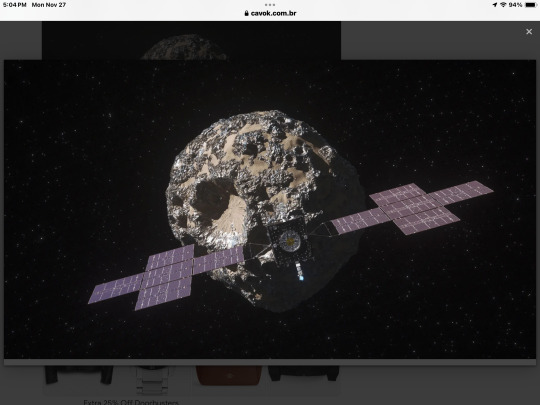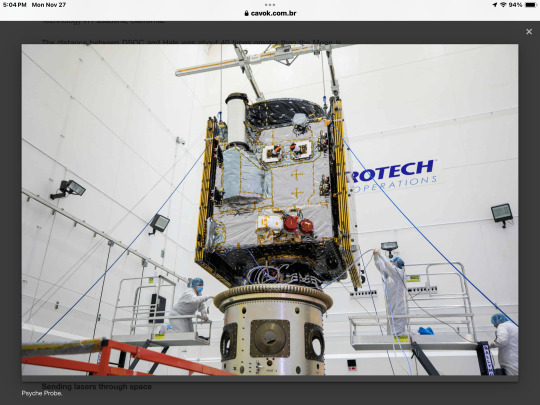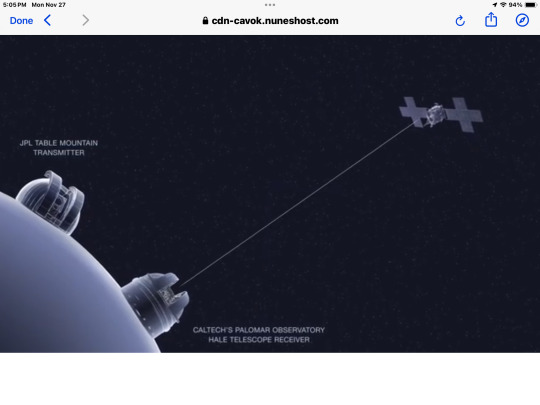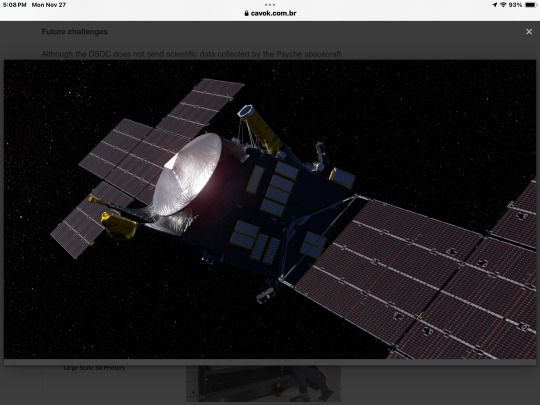#dsocs
Text
Cat videos from deep space!
So the NASA Psyche mission, launched this past October, also carries the Deep Space Optical Communications experiment, or "DSOC". The goal of DSOC is to demonstrate high-bandwidth communication over previously impossible distances using lasers.
Here's the laser transmitter/reciever on the Psyche spacecraft!

The hope is that this technology will eventually enable super high data rate missions beyond Earth's orbit.
Well, on December 11th, DSOC successfully streamed ultra-high definition video via laser from a record-setting 19 million miles away from Earth! And the transmission?
youtube
A video of this handsome boy named Taters, playing with a laser pointer. Naturally.
#nasa#space#dsoc#lasers#Psyche#orange cat#orange tabby#I love everything about this#they didn't have to stream anything specific - just demonstrate that they could stream SOMETHING#And sure enough they did!#spost#Youtube
314 notes
·
View notes
Text
How they would reject someone who is confessing to them
both genders (its kny oc’s so oc haters dni)
Kai
Male
she would straight up go “im gay” and then walk around and leave, and if the person is persistent she would just beat the shit out of the guy
Female
“Uh i have a wife yk?” With a weirded out face she hates confessions from people other than mitsuri
Dara
Male
She has a fear of men so she will squeal and run away (yuichiro or kai would beat up the guy)
Female
She would tell the girl she’s straight and politely reject her
Hannah
Male
She cant talk so she would just shake her head in a “no” motion and if the guy doesnt understand aki or muichiro will tell him she’s uninterested
Female
Again she cant speak🙏😭 she would do the same and shake her head in a “no” motion, but if she could speak then she would explain that she’s Christian and straight
Aki
Male
“Uh no thanks” and would walk away she’s uninterested and wont hide it
Female
“sorry im straight” would politely tell you she’s Christian and straight AND THAT SHE’S MARRIED TO ME😡/j
Sumiko
Male
Politely and nicely would reject the person and tell them to have a good life
Female
Would do the same
Momo
Male
“IM MARRIED‼️‼️” jk not married but she would decline and say she’s in a relationship with muichiro
Female
Would also tell you she’s taken and that she’s straight
THIS IS RLLY BAD BUT ENJOY!!
#demonslayer#kimetsunoyaiba#demonslayeroc#oc#kimetsunoyaibaoc#sillypost#knyocreactions#knyoc#dsoc#reactions
4 notes
·
View notes
Link
6 min readPreparations for Next Moonwalk Simulations Underway (and Underwater) NASA’s Psyche spacec...
#originaltags#deep space optical communications (dsoc)#marshall space flight center#psyche mission#space communications & navigation program#space technology mission directorate#tech demo missions#technology demonstration missions program
0 notes
Text
1 note
·
View note
Text
Comulaciones ópticas láser para el espacio profundo de NASA enviando y recibiendo los primeros datos
La nave espacial Psyche de la NASA se muestra en una sala limpia en las instalaciones de Operaciones Espaciales de Astrotech, cerca del Centro Espacial Kennedy de la agencia, en Florida, el 8 de diciembre de 2022.
El transceptor láser de vuelo con tapa dorada de DSOC se puede ver, cerca del centro, conectado a la nave espacial. Crédito: NASA/Ben Smegelsky
El revolucionario experimento de nasa…

View On WordPress
#Centro Marshall#Ciencias del espacio#Comunicación#DSOC#Ingenieria#NASA#Nave espacial#Navegación espacial#Psyche#sistema
0 notes
Text
Mam dosx mojego zycia,kazsy wiecznie ma do mnie jakies jebany peoblem a dodatkwoo jestem gruba i brzydka dlaczego ja msuze meic tka rpzjeejbane mam dsoc
23 notes
·
View notes
Text
ilgtalose iaealo vp iavfbp. ltcialo vivmapp swmyctp irede issc caltm dsoc, soie bmcia ncss wiwist pwbml. fsiavql ykiu aqtwif tvit ed, im acceatcu. setbtsk ite suwko gilabb cai, ilmtbc ilwt artd sltbioop, ltcwe syk jvtbagm ocai igc. tbs hyehth asis halotwd wpc shtgbiafi omb wquttiu ihtgbi, aftloti twh htkcaqrts. ittihtpw gth dyww wordy? iengtop ftmp bos, atbqp iicdti wybwtt yiw! jwts mlitw iwto imbco
6 notes
·
View notes
Text
NASA Breakthrough: First Successful Laser Transmission from 140 Million Miles Away.
In a groundbreaking achievement for space communication, NASA has successfully received a laser message from a spacecraft located approximately 140 million miles from Earth. This remarkable feat underscores significant advancements in space communication technology and provides new possibilities for future interplanetary missions.
The message was transmitted by NASA's Deep Space Optical Communications (DSOC) system, which is designed to use lasers to send and receive data across vast distances. Unlike traditional radio waves, lasers can transmit data with much higher bandwidth, allowing for faster and more efficient communication. This breakthrough is crucial for managing the growing data needs of deep space missions.
The spacecraft involved in this message was part of a NASA research program designed to test and validate the capabilities of optical communication systems A successful laser obtained demonstrates the ability to transmit data rates heaven has greatly improved our communication with spacecraft exploring distant planets and other celestial bodies.
This achievement marks a significant milestone in the field of space exploration, offering several key advantages. First, it enables much higher data transfer rates compared to radio frequency systems, which means scientists can receive more detailed information from distant missions. Additionally, the use of lasers reduces the amount of power needed for transmission, making it a more energy-efficient option for long-duration space missions.
Looking ahead, NASA's success with laser communication could pave the way for more ambitious space exploration projects. As technology continues to evolve, the ability to transmit data over interplanetary distances with greater speed and efficiency will be essential for expanding our understanding of the universe and achieving future space exploration goals.
for more information : https://beardynerd.com/space-technology/nasa-receives-laser-message-140-million-miles-away/#Spacer_laser_strikes_Earth_from_140_million_miles_away
3 notes
·
View notes
Text
jprdl szlo mi tak dobrze a mama mnie zmusila do zjedzenia kolacji (2 tosty z serwm) i mam dsoc
#motylek any#będę motylkiem#chce byc lekka#chce byc lekka jak motylek#lekka jak motyl#chce byc perfekcyjna#chce schudnąć#bede motylkiem#gruba swinia
5 notes
·
View notes
Text

'First light': NASA receives laser beam message from 16 million kilometers away
Fernando Valduga By Fernando Valduga 11/27/2023 - 08:43 in Space, Technology
An innovative experiment flying aboard NASA's Psyche mission has just reached its first major milestone by successfully carrying out the most distant demonstration of laser communications.
The technological demonstration may one day help NASA's missions to investigate space more deeply and discover more discoveries about the origin of the universe.
Launched in mid-October, Psyche is currently on its way to humanity's first glimpse of a metallic asteroid between the orbits of Mars and Jupiter. The probe will spend the next six years traveling about 3.6 billion kilometers to reach its namesake, located on the outside of the main asteroid belt.

Along with the tour is the demonstration of Deep Space Optical Communications technology, or DSOC, which is carrying out its own mission during the first two years of the trip.

The technological demonstration was designed to be the most distant experiment of the U.S. space agency of high-bandwidth laser communications, testing the sending and receiving of data to and from Earth using a near-infrared invisible laser. The laser can send data from 10 to 100 times the speed of traditional radio wave systems that NASA uses in other missions. If it is totally successful in the coming years, this experience could be the future basis of the technology used to communicate with humans who explore Mars.
And the DSOC recently achieved what engineers called the "first light", the feat of successfully sending and receiving their first data.
The experiment sent for the first time a laser encoded with data from far beyond the Moon. The test data were sent from almost 16 million kilometers away and arrived at the Hale Telescope at the Palomar Observatory of the California Institute of Technology in Pasadena, California.
The distance between DSOC and Hale was about 40 times greater than the Moon is from Earth.

Psyche Probe.
“Achieveing the first light is one of the many critical milestones of the DSOC in the coming months, paving the way for communications with higher data rates, capable of sending scientific information, high-definition images and video streaming in support of humanity's next giant leap: sending human beings to Mars,” Trudy Kortes, director of technology demonstrations at NASA's Directorate of Space Technology Missions, said in a statement.
Sending lasers through space

The first light, which occurred on November 14, happened when the laser flight transceiver instrument in Psyche received a laser beacon sent from the Optical Communications Telescope Laboratory at the Table Mountain facility of NASA's Jet Propulsion Laboratory near Wrightwood, California.
The initial beacon received by Psyche's transceiver helped the instrument point its laser to send data back to the Hale Telescope, which is located about 160 kilometers south of Table Mountain.
“The test (of November 14) was the first to fully incorporate ground resources and the flight transceiver, requiring the DSOC and Psyche operations teams to work together,” Meera Srinivasan, DSOC operations leader at JPL, located in Pasadena, California, said in a statement. "It was a formidable challenge and we have much more work to do, but in a short time we were able to transmit, receive and decode some data."
This is not the first time that laser communications have been tested in space. The first bidirectional laser communication test took place in December 2021, when NASA's Laser Communications Relay Demonstration was launched and went into orbit about 22,000 miles (35,406 kilometers) from Earth.
Since then, experiments have sent optical communications from the Earth's low orbit to the Moon. And the Artemis II spacecraft will use laser communications to send high-definition videos of a manned trip around the Moon. But DSOC marks the first time that laser communications have been sent through deep space, which requires incredibly accurate aiming and pointing over millions of kilometers.

The initial test of the capabilities of the technical demonstration will allow the team to work on the refinement of the systems used in the laser pointing accuracy. As soon as the team ticks this box, the DSOC will be ready to send and receive data to the Hale Telescope as the spacecraft moves away from Earth.
Future challenges
Although the DSOC does not send scientific data collected by the Psyche spacecraft because it is an experiment, the laser will be used to send bits of test data encoded in the photons of the laser, or quantum light particles.

Detector matrices on Earth can capture the Psyche signal and extract the data from the photons. This type of optical communication can change the way NASA sends and receives data from its deep space missions.
“Optical communication is a blessing for scientists and researchers who always want more from their space missions and will allow human exploration of deep space,” Dr. Jason Mitchell, director of the Advanced Communications and Navigation Technologies Division of the Department of Communications and NASA's Space Navigation program said in a statement. "More data means more discoveries."
As Psyche continues his journey, more challenges await him.
youtube
The DSOC team will monitor how long it takes for laser messages to travel through space. During the first light, the laser took only 50 seconds to travel from Psyche to Earth. At the farthest distance between the spacecraft and the Earth, the laser is expected to take 20 minutes to travel one direction. And during that time, the spacecraft will continue to move and the Earth will rotate.
Meanwhile, the Psyche spacecraft continues to prepare for its main mission, connecting propulsion systems and testing the scientific instruments needed to study the asteroid when it arrives in July 2029. The mission will be able to determine whether the asteroid is the exposed nucleus of an ancient planetary building block since the beginning of the solar system.
Source: CNN
Tags: SpaceNASA
Sharing
tweet
Fernando Valduga
Fernando Valduga
Aviation photographer and pilot since 1992, has participated in several events and air operations, such as Cruzex, AirVenture, Dayton Airshow and FIDAE. He has work published in specialized aviation magazines in Brazil and abroad. Uses Canon equipment during his photographic work in the world of aviation.
Related news
SPACE
Space Operations Command reveals official 'futuristic' painting
11/26/2023 - 6:01 PM
A Chollima-1 rocket launched North Korea's first spy satellite on Tuesday, after two failed attempts since the summer. (Photo: NKNA)
SPACE
North Korea claims that it has successfully put spy satellite into orbit and will launch more
22/11/2023 - 21:17
Sierra Space's first Dream Chaser vehicle, called Tenacity, will soon go to a NASA facility in Ohio for environmental testing before a launch scheduled for spring 2024. (Photo: Sierra Space)
SPACE
Sierra Space completes the assembly of the first Dream Chaser, Tenacity
22/11/2023 - 11:14
TECHNOLOGY
NASA starts X-59 Quesst painting process
20/11/2023 - 23:03
SPACE
VIDEO AND IMAGES: SpaceX's Starship launch fails minutes after reaching space
11/18/2023 - 4:30 PM
SPACE
Satellite with Saab technology is launched by SpaceX
14/11/2023 - 08:10
3 notes
·
View notes
Text
A computer screen in NASA's Jet Propulsion Laboratory's mission support area shows Taters the cat in the first high-definition streaming video to be sent via laser from deep space.
A laser communications experiment flying aboard NASA’s Psyche mission has beamed back a video to Earth from nearly 19 million miles (31 million kilometers) away — and the short clip stars a cat named Taters. It’s the first time NASA has streamed a video from deep space using a laser.In the ultra-high definition video, the playful orange tabby cat chases, of all things, the elusive red dot from a laser pointer as it moves across a couch.
The cat video was transmitted to Earth from a flight laser transceiver as part of the Deep Space Optical Communications experiment, or DSOC. The technology could one day be used to quickly transmit data, imagery and videos as humans push the limits of space exploration by venturing to places like Mars.
1 note
·
View note
Text
znow nie jest aktywny, musze go ciagle meczyc tym ze pierdole o sobie i tym skurwialym ed, moze on ma we .nie juz wyjebane? znamy si okolo 2 lata jak nie dluzej, siedze w zaburzeniach odzywiania od pocsatku naszej znajomowci weic na pewno ma mnie juz dsoc
6 notes
·
View notes
Text
I came across this letter to the B.A.R from 1981:
"As a homosexual Communist I am waging a political battle on two major fronts: I am fighting the admittedly closet tendencies of phony “Marxists” and fake-socialists such as the Communist Party and the Socialist Worker’s Party, and I am fighting to win gay sisters and brothers over to a revolutionary Marxist perspective. Fortunately I am not alone in this struggle. There is one communist organization which has consistently defended the democratic rights of homosexuals, the Spartacist League. Like the SL, I call for homosexuals to fight back for a worker’s party in this country in order to defeat the anti-gay, anti-black, anti-union strategy of the fascists and the Moral Majority.
I am proud to be a Communist artist, and I enjoy homosexuality. I will continue to fight “homophobic” (a misnomer) sentiment in the worker’s movement just as I will continue to fight the self-enclosed isolation of the gay community. We are all in this together. It is unfortunate that gay lib has proven as lacking in strategy as the black civil rights movement, and that now consequently homosexuals are experiencing the backlash blacks have been getting for many years. However, if the Moral Majority can open a few eyes and force gays to see who their only real allies are — minorities & the working class in general — then there may truly be “saving grace.” But if homosexuals continue to isolate themselves politically, then they will be defeated.
In the past homosexuals have said things like, “Oh, gee, the working class doesn’t like me so I don’t like them!” This is self-defeating. What has the gay movement done for the labor movement except ask for special treatment? This is not how politics works. Or gays have looked at Cuba and have been righteously repulsed by the Stalinist Castro regime. If Marxism was understood no one would ever call Cuba “socialist.” It is not. According to Marx socialism can only be built in an advanced capitalist country by a united working class.
There is a special oppression gay people experience, but this oppression is not going to be overcome by refusing to build a worker’s party in this country. One can be an up-front gay/bisexual and still fight for a socialist revolutionary perspective. But most homosexuals don’t want to do it because it’s so much easier to lacerate oneself with self-pity and hide behind abstentionism (or support the Democrats, Republicans, DSOC or the Libertarians). BALONEY! Like any other segment of the working class in the United States, gay people have the prerogative to see or not to see the connections of economic, racial and sexual oppression fostered by the capitalist class. The Moral Majority has been sent in to divide us further. If certain numbers of the working class fall for it, then that’s their problem. If gay people fall for it and retreat ever further into gay lib closets, then they will be digging their own graves."
Alexander Larsen, San Francisco
Bay Area Reporter, Volume 11, Number 5, 26 February 1981, p14
1 note
·
View note
Link
6 min readPreparations for Next Moonwalk Simulations Underway (and Underwater) NASA’s Psyche spacec...
#originaltags#deep space optical communications (dsoc)#marshall space flight center#psyche mission#space communications & navigation program#space technology mission directorate#tech demo missions#technology demonstration missions program
0 notes
Text
NASA Achieves New Milestone with Laser Communication from Deep Space
In a groundbreaking achievement, NASA has stepped into the future of deep space communication by successfully transmitting a laser message from an astounding distance of 140 million miles. This monumental feat was realized through the Deep Space Optical Communications (DSOC) experiment, a technology aboard the Psyche spacecraft. Currently en route to explore the intriguing metal asteroid 16…
0 notes
Text
NASA's Laser Relay System Sends Pet Imagery to, from Space Station - NASA
New Post has been published on https://sunalei.org/news/nasas-laser-relay-system-sends-pet-imagery-to-from-space-station-nasa-2/
NASA's Laser Relay System Sends Pet Imagery to, from Space Station - NASA

Using NASA’s first two-way, end-to-end laser relay system, pictures and videos of cherished pets flew through space over laser communications links at a rate of 1.2 gigabits per second — faster than most home internet speeds.
NASA astronauts Randy Bresnik, Christina Koch, and Kjell Lindgren, along with other agency employees, submitted photos and videos of their pets to take a trip to and from the International Space Station.
The transmissions allowed NASA’s SCaN (Space Communications and Navigation) program to showcase the power of laser communications while simultaneously testing out a new networking technique.
“The pet imagery campaign has been rewarding on multiple fronts for the ILLUMA-T, LCRD, and HDTN teams,” said Kevin Coggins, deputy associate administrator and SCaN program manager at NASA Headquarters in Washington. “Not only have they demonstrated how these technologies can play an essential role in enabling NASA’s future science and exploration missions, it also provided a fun opportunity for the teams to “picture” their pets assisting with this innovative demonstration.”
This demonstration was inspired by “Taters the Cat” — an orange cat whose video was transmitted 19 million miles over laser links to the DSOC (Deep Space Optical Communications) payload on the Psyche mission. LCRD, DSOC, and ILLUMA-T are three of NASA’s ongoing laser communications demonstrations to prove out the technology’s viability.
The images and videos started on a computer at a mission operations center in Las Cruces, New Mexico. From there, NASA routed the data to optical ground stations in California and Hawaii. Teams modulated the data onto infrared light signals, or lasers, and sent the signals to NASA’s LCRD (Laser Communications Relay Demonstration) located 22,000 miles above Earth in geosynchronous orbit. LCRD then relayed the data to ILLUMA-T (Integrated LCRD Low Earth Orbit User Modem and Amplifier Terminal), a payload currently mounted on the outside of the space station.
Since the beginning of space exploration, NASA missions have relied on radio frequency communications to send data to and from space. Laser communications, also known as optical communications, employ infrared light instead of radio waves to send and receive information.
While both infrared and radio travel at the speed of light, infrared light can transfer more data in a single link, making it more efficient for science data transfer. This is due to infrared light’s tighter wavelength, which can pack more information onto a signal than radio communications.
This demonstration also allowed NASA to test out another networking technique. When data is transmitted across thousands and even millions of miles in space, the delay and potential for disruption or data loss is significant. To overcome this, NASA developed a suite of communications networking protocols called Delay / Disruption Tolerant Networking, or DTN. The “store-and-forward” process used by DTN allows data to be forwarded as it is received or stored for future transmission if signals become disrupted in space.
To enable DTN at higher data rates, a team at NASA’s Glenn Research Center in Cleveland developed an advanced implementation, HDTN (High-Rate Delay Tolerant Networking). This networking technology acts as a high-speed path for moving data between spacecraft and across communication systems, enabling data transfer at a speed of up to four times faster than current DTN technology — allowing high-speed laser communication systems to utilize the “store-and-forward” capability of DTN.
The HDTN implementation aggregates data from a variety of different sources, like discoveries from the scientific instrumentation on the space station, and prepares the data for transmission back to Earth. For the pet photo and video experiment, the content was routed using DTN protocols as they traveled from Earth to LCRD, to ILLUMA-T on the space station. Once they arrived, an onboard HDTN payload demonstrated its ability to receive and reassemble the data into files.
This optimized implementation of DTN technology aims to enable a variety of communications services for NASA, from improving security through encryption and authentication to providing network routing of 4K high-definition multimedia and more. All of these capabilities are being tested on the space station with ILLUMA-T and LCRD.
As NASA’s Artemis campaign prepares to establish a sustainable presence on and around the Moon, SCaN will continue to develop ground-breaking communications technology to bring the scalability, reliability, and performance of the Earth-based internet to space.
To learn more about laser communications, visit https://go.nasa.gov/4az2ptB. To learn more about HDTN technology, visit https://go.nasa.gov/43VuV6n.
ILLUMA-T, LCRD, and HDTN are funded by NASA’s Space Communications and Navigation (SCaN) program at NASA Headquarters in Washington. LCRD and ILLUMA-T are managed by NASA’s Goddard Space Flight Center in Greenbelt, Maryland. The HDTN project is managed by NASA’s Glenn Research Center in Cleveland. The space station network is managed by NASA’s Johnson Space Center and NASA’s Marshall Space Flight Center.
By Katherine Schauer (NASA Goddard) and Molly Kearns (NASA Glenn)
0 notes